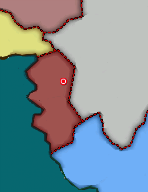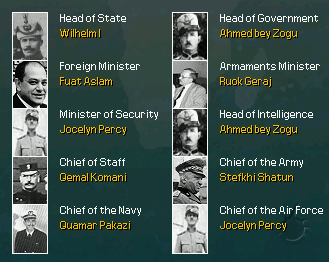Albania
From Kaiserreich
| ||||
| Anthem Himni i Flamurit (Hymn to the Flag) | ||||

| ||||
|
| ||||
| Official Language | Albanian | |||
| Capital | Tirana | |||
| Head of State | Wilhelm I von Wied | |||
| Head of Government | Ahmed Bey Zogu | |||
| Establishment - Independance | November 28, 1912 | |||
| Government | Autocratic monarchy, under the authority of the Ottoman Empire | |||
| Currency | Albanian Lek | |||
| Area | 28,748 km² | |||
| Population | About 1 million | |||
Albania is a country in Southeast Europe. It borders Croatia, a constituent part of Austria-Hungary, to the north, Bulgaria to the east and Greece to the south.
Contents |
History
In 15th century, Albanian national hero Skanderbeg fought back the Turkish invaders. However after his death and the fall of Krujas and Shkodra the country came under four centuries of foreign rule. Large numbers of the population converted to Islam in the 16th and 17th century, allowing them to rise into the highest offices - eleven Grand Veziers came from Albania and Mohammed Ali founded a dynasty in Egypt in 1805. The Islamization brought support for the resistance against Serbs and Greek as well as against the Ottoman rule itself. Only at the end of the 19th century the national renaissance began with the founding of the League of Prizren. During the First Balkans War in 1912 the Albanian national congress in Vlore declared the country's independence which was accepted by the major powers in 1913 upon the condition that Wilhelms of Wied would be accepted as Prince.
The outbreak of the Weltkrieg presented more problems for the country as Austria-Hungary demanded Albanian soldiers to fight alongside them. When Prince Wilhelm refused, citing the neutrality of Albania in the Treaty of London, the remuneration that he had been receiving was cut off. His regime collapsed and Prince Wilhelm left the country on September 3 1914 and joined the Imperial German Army, even if formally he still was the Albanian Head Of State.
On 1921, the Peace with Honour officially determined the status of Albania: a restored principality under the authority of the Prince Wilhelm, not under Austrian influence anymore, but as a formal vassal of the Ottoman caliph. Even if revolts started to break out, Prince Wilhelm was able to regain control of the country thanks to the Ottoman support. However, the price he had to pay was the Ottoman control over the country's inner politics, such as forcing the Prince to appoint the very ambitious Ahmed Zogu as his Prime Minister.
Politics
|
Sovereign Prince of Albania: His Highness Wilhelm I (Skanderbeg II) von Wied (born 26 March 1876)
Prime Minister and Director of Secret Police: Ahmed Bey Zogu (born 8 October 1895)
Minister of Foreign Affairs: Fuat Aslam
Minister of Finance: Ruok Geraj
Minister of Internal Affairs and Commander-in-Chief of the Albanian Army Air Service: Jocelyn Percy (born 1871)
Inspector General of the Military Department: Qemal Komani
Commander-in-Chief of the Albanian Gendarmerie: Stefkhi Shatun
Commander-in-Chief of the Albanian Naval Forces: Quamar Pakazi
Military
Army
Albania has a very small army, usually used only to repress the occasional revolt, and his defence is guaranteed by the presence of Ottoman troops inside its borders.
Because of the country's poor economy and the interference of the Ottoman Empire, Albania never attempted a military naval or air program, despite the presence of a decent airport and a good port in its capital Tirana.
Foreign relations
Under the political, economic and military authority of the Ottoman Empire.
Friendly relations with Germany, United Baltic Duchy, Bulgaria, Austria and Russia.
Unfriendly relations with Commune of France, Union of Britain, Hungary, Spain and National France.


